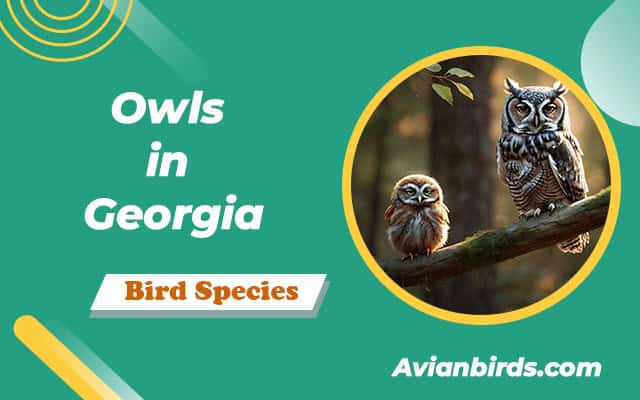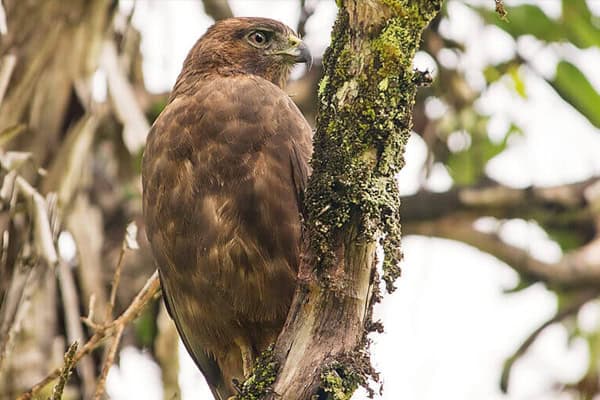12 Owls in Colorado (With Pictures)
Are you ready to uncover the secrets of owls in Colorado. These night hunters fascinate with their diversity. From the elusive Northern Pygmy to the regal Great Horned Owl, they’re captivating creatures. I’ve researched their lives in our state’s forests and grasslands. We’ll delve into their traits, diets, nesting habits, and the conservation efforts that safeguard them. Discover why these owls play a vital role in Colorado’s ecosystem. Let’s explore their world together!
Here are the main points:
- Owls in Colorado offer a captivating glimpse into the diverse species that inhabit the state.
- Through stunning photographs, we showcase the appearance, behavior, and habitat of Colorado’s owl species.
- Uncover the unique hunting habits, distinctive calls, and remarkable features of these remarkable creatures.
- Explore the challenges and threats faced by some Colorado owl species, highlighting the need for conservation efforts.
1. Eastern Screech-Owl

- Life Expectancy: 8 to 10 years
- Size: 16 to 25 centimeters (6.5 to 10 inches)
- Weight: 121 to 244 grams (4.25 to 8.5 ounces)
- Wingspan: 46 to 61 centimeters (18 to 24 inches)
- Conservation Status: Least Concern
Eastern Screech-Owl is a fascinating bird renowned for its exceptional adaptability and often sighted across various regions of Eastern North America, including Mexico. Surprisingly, it seems unaffected by human presence and can even thrive in urban environments.
Also, This species exhibits two distinct color variations: reddish hues in southern populations and greyish tones in the north. Scientists speculate that these differences are influenced by the natural woodland colors in their habitats.
Known for its solitary habits, the Eastern screech owl typically pairs up during the breeding season, which occurs in April. During courtship, these owls engage in bonding rituals to establish lifelong connections.
After mating, they construct nests within the hollow trunks of dense forest trees. While usually monogamous, some male owls have been observed mating with multiple females in a single breeding season, leading to the eviction of the initial female and the laying of a new clutch of eggs.
Being adaptable predators, Eastern Screech-Owls hunt a variety of prey depending on their surroundings. In Colorado, they mainly target small mammals such as voles, mice, shrews, and rats. Moreover, they also consume a significant number of insects like beetles, moths, and other invertebrates, particularly when mammal populations are low.
Moreover, they feed on small reptiles, birds, and amphibians, and occasionally indulge in fruits and berries. Also, these owls are primarily nocturnal hunters, relying on their acute hearing to locate prey such as squirrels and small birds. After consuming their prey whole, they regurgitate the undigested parts, such as fur, feathers, and bones, in the form of pellets.
Moreover, the Eastern screech owls in colorado is not currently listed as endangered, like many other owl species, it faces threats such as poisoning from prey and habitat disturbance or destruction. The International Union for Conservation of Nature’s Red List categorizes the Eastern screech owl as “Least Concern.”
Eastern Screech-Owl Facts
- The Eastern screech owl is native to North America, a region also inhabited by the boreal owl, which shares similar habitats.
- They have excellent hearing, allowing them to locate prey in complete darkness.
- Eastern screech owls mate for life and often return to the same nesting site.
- These owls are nocturnal, meaning they are most active during the night.
| Appearance | Behavior | Habitat |
|---|---|---|
| Small owl species with distinctive yellow eyes | Fierce hunter of small mammals, birds, insects, and reptiles | Found in forests, woodlands, and urban areas of Colorado |
2. Great Horned Owl

- Scientific name: Bubo virginianus
- Lifespan: 25 – 50 years
- Size: 43 to 64 centimeters (17 to 25 inches)
- Weight: 1200 to 1600 grams (2.64 to 3.52 pounds)
- Wingspan: 91 to 153 centimeters (3 feet 0 inches to 5 feet 0 inches)
- Conservation Status: Least Concern
When it comes to majestic and awe-inspiring owls, the Great Horned Owl takes center stage. As one of the largest owl species found in Colorado, it commands attention with its impressive size and striking appearance.
The Great Horned Owls, also known as Bubo virginianus, is a true icon of Colorado owl species. With its powerful build and notable tufts of feathers resembling “horns” on its head, this magnificent creature is a sight to behold.
One of the distinguishing features of the Great Horned Owl is its large size. On average, adults can reach a height of 18 to 25 inches (45 to 63 cm) and have a wingspan of up to 4.5 feet (137 cm). This makes them one of the largest owls in North America.
“The Great Horned Owl is an apex predator in the avian world, known for its exceptional hunting skills and adaptability.”
These charismatic owls have a varied diet that includes a wide range of prey, from small rodents to larger mammals such as raccoons and skunks. Their strong talons and sharp beaks enable them to capture and subdue their prey with ease.
Great Horned Owls are spread across various habitats in Colorado, including forested areas, canyons, and even cities. They are extremely adaptable and can make their homes in diverse environments, making them one of the most adaptable owl species.
Unique Adaptations of the Great Horned Owl
One of the remarkable adaptations of the Great Horned Owl is its exceptional night vision. Their large, forward-facing eyes provide excellent depth perception, allowing them to navigate through darkness with incredible precision.
Another distinctive characteristic of these owls is their remarkable camouflage. Their mottled brown feathers blend seamlessly with tree bark and other natural surroundings, making them virtually invisible to unsuspecting prey or potential predators.
Habitat Nesting and Reproduction
The Great Horned Owls do not build nests of their own but instead repurpose the nests of other large birds or use cavities in trees. They are also known to nest on rocky ledges or even on the ground when suitable sites are unavailable, adapting to environments monitored by Colorado Parks for conservation efforts.
During nesting season, the female owl typically lays two to three eggs, which she incubates for about a month. The male assists in bringing food to the nest, ensuring the survival of the growing chicks. After hatching, the young owls remain in the nest for several weeks before they begin to venture out on their own.
In conclusion, the Great Horned Owl is a magnificent and iconic species of owl found in Colorado. With their large size, impressive hunting skills, and unique adaptations, these owls epitomize the diversity and beauty of Colorado’s owl species.
| Characteristics | Details |
|---|---|
| Scientific Name | Bubo virginianus |
| Size | Height: 18-25 inches (45-63 cm) Wingspan: Up to 4.5 feet (137 cm) |
| Diet | Small rodents, mammals (e.g., raccoons, skunks) |
| Habitat | Forested areas, canyons, urban environments |
| Adaptations | Night vision, camouflage |
| Nesting | Reuses nests, tree cavities, rocky ledges, ground |
| Reproduction | Lays 2-3 eggs, chicks remain in the nest for several weeks |
3. American Barn Owl

-
Scientific name: Tyto furcata
-
Life span: 10 years
-
Size: 34 to 38 centimeters (13 to 15 inches)
-
Weight: 400 to 600 grams (0.88 to 1.3 pounds)
-
Wingspan: 29 to 36 centimeters (11 to 14 inches)
-
Conservation Status: Least Concern
The American Barn Owl is a captivating nocturnal owl species found in Colorado. With its heart-shaped face and graceful flight, this owl is truly a sight to behold. It is known for its distinct ivory-white to pale tan plumage, which allows it to blend seamlessly into its surroundings.
As a nocturnal species, the American Barn Owl is most active during the night, using its exceptional night vision and sharp hearing to hunt for its prey. It primarily feeds on small mammals such as mice, voles, and rats, making it an effective pest controller.
This owl species has a wide range of habitats it can occupy. You can find the American Barn Owl in a variety of environments including grasslands, agricultural fields, wooded areas, and even urban areas where there are suitable nesting sites and an abundant food supply.
When it comes to nesting, the American Barn Owl prefers to nest in barns, abandoned buildings, or tree cavities. This nesting behavior is where it gets its common names – “Barn Owl” and “American Barn Owl.”
“The American Barn Owl’s adaptability and hunting success make it a valuable predator in various ecosystems.”
– Dr. Sarah Evans, owl conservationist
Migratory Patterns
- The American Barn Owl can be observed in Colorado year-round as it is a non-migratory species.
- While they may stay in one area throughout the year, they may shift their nesting locations depending on food availability and environmental conditions.
Conservation Status
The American Barn Owl population is currently stable, but it is important to protect their nesting habitats and ensure a continuous food supply. The loss of suitable nesting sites such as old barns and trees, as well as the use of rodenticides, pose threats to this species.
| Species | Conservation Status |
|---|---|
| American Barn Owl | Stable |
4. Barred Owl
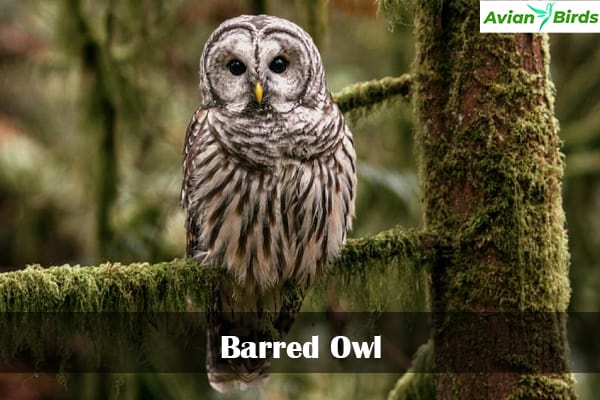
-
Scientific name: Strix varia
-
Life span: 8 years
-
Size: 40 to 63 centimeters (15 to 25 inches)
-
Weight: 610 to 1,150 grams (1.34 to 2.54 pounds)
-
Wingspan: 96 to 125 centimeters (38 to 49 inches)
-
Conservation Status: Least Concern
The Barred Owl is an owl species that can be found in Colorado. Known for its distinctive hooting call, this owl species is a fascinating resident of Colorado’s forests. With its beautiful barred plumage and dark brown eyes, the Barred Owl is a sight to behold.
Barred Owls in Colorado have a preferred habitat of dense forested areas, especially near swamps and wetlands. These owls are highly adaptable and can also be found in suburban areas with mature trees. They are known for their territorial behavior and often have large home ranges.
“The unmistakable call of the Barred Owl echoes through the trees, creating an enchanting atmosphere in the Colorado wilderness.”
The Barred Owl is a skilled hunter and primarily feeds on small mammals, including rodents and rabbits. Their silent flight and keen hearing make them efficient predators, able to swoop down and catch their prey with precision.
Appearance
The Barred Owl is a medium-sized owl with a rounded head and a wingspan of around 3 feet. It has a brownish-gray plumage with horizontal bars across its chest, giving it its name. Its eyes are dark brown and set against a pale facial disc. This owl species also has long, feathered ear tufts that add to its distinctive appearance.
Conservation Status
The Barred Owl is not currently listed as a threatened or endangered species. However, habitat loss and fragmentation can have a significant impact on its population. Conservation efforts focused on preserving and protecting forested areas are crucial for the long-term survival of the Barred Owl in Colorado.
Fun Fact
The hooting call of the Barred Owl has a distinct pattern that resembles the phrase “Who cooks for you? Who cooks for you all?”. This unique call is often used to identify their presence in the forest and adds to the allure of encountering these majestic creatures in the wild.
5. Short-eared Owl

Scientific name: Asio flammeus
Life span: 12 years
Size: 34 to 43 centimeters (13 to 17 inches)
Weight: 206 to 475 grams (7.3 to 16.8 ounces)
Wingspan: 85 to 110 centimeters (33 to 43 inches)
Conservation Status: Least Concern
The Short-eared Owl is a fascinating species known for its unique hunting behavior. Found in Colorado, this owl is a prominent member of Colorado’s owl species, captivating bird enthusiasts with its intriguing characteristics.
Measuring approximately 12-16 inches in length, the Short-eared Owl has a wingspan of about 33-40 inches. It is easily recognizable by its short ear tufts and distinctive facial disk. With mottled brown plumage and bright yellow eyes, this owl blends perfectly into its grassland habitat.
Unlike most owls that are strictly nocturnal, the Short-eared Owl is crepuscular, meaning it is primarily active during the hours around dawn and dusk. This unique behavior allows them to hunt in open fields, marshes, and grasslands where their main prey small mammals, including voles and mice, reside.
Short-eared Owls are skilled hunters, utilizing their acute hearing and sharp eyesight to locate their prey. They fly low over the ground, hovering and gliding as they search for movement. Once they spot their target, they swoop down swiftly, capturing their prey with their powerful talons.
During the breeding season, which typically occurs from April to June, the Short-eared Owl can be seen performing aerial displays, consisting of acrobatic flights and patterned wing claps. These displays are not only a courtship ritual but also a means of defending their territory.
Colorado offers suitable habitats for the Short-eared Owls, including areas with short grasses, marshes, and shrublands. In Colorado, you can find them in regions such as the San Luis Valley and wetlands along the Front Range.
Observing this fascinating owl in its natural habitat can be a rewarding experience for bird enthusiasts and wildlife photographers alike. However, it’s important to remember to maintain a respectful distance and not disturb their nesting sites or hunting activities.
Fun Fact:
The Short-eared Owl was once considered a threatened species due to habitat loss and degradation. However, conservation efforts and land management practices have helped stabilize their population in some regions of Colorado.
Short-eared Owl Characteristics
| Characteristics | Description |
|---|---|
| Size | 12-16 inches in length |
| Wingspan | 33-40 inches |
| Plumage | Mottled brown |
| Eyes | Bright yellow |
| Habitat | Grasslands, marshes, and shrublands |
| Main Prey | Small mammals (voles, mice) |
6. Long-eared Owl in Colorado
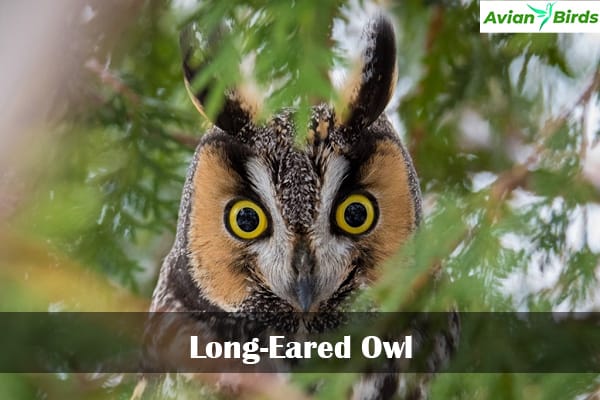
- Scientific name: Asio otus
- Life span: 10 to 27 years
- Size: 31 to 40 centimeters (12 to 16 inches)
- Weight: 160 to 435 grams (5.6 to 15.3 ounces)
- Wingspan: 86 to 102 centimeters (2 feet 10 inches to 3 feet 4 inches)
- Conservation Status: Least Concern
The Long-eared Owl is a fascinating species of owl found in Colorado. They are known for their remarkable ear tufts and dark eye mask, which give them a distinctive appearance akin to that of the spotted owl. These owls are medium-sized and have a wingspan of around 35-39 inches.
Long-eared Owls are primarily nocturnal and are most active during the night. During the day, they typically roost in dense coniferous forests, where they blend in seamlessly with their surroundings. They prefer habitats with thick undergrowth and trees for their nesting sites.
When it comes to hunting, Long-eared Owls have fantastic hearing abilities. Their highly sensitive ears are situated asymmetrically on the sides of their head, allowing them to accurately locate prey based on sound alone, a hunting technique shared by both the boreal and spotted owl species. They primarily feed on small mammals, such as mice, voles, and shrews, but may also prey on young owlets if the opportunity arises.
The Long-eared Owl is a remarkable species with unique adaptations that make it an expert hunter in the Colorado wilderness.
This species is known to migrate from their breeding grounds in the northern parts of the United States and Canada to the southern parts of their range, including Colorado, during the winter months. These migratory patterns are influenced by the availability of prey and suitable habitat.
Conservation Status
The Long-eared Owl faces various threats to its population, including habitat loss and degradation due to urbanization and deforestation. The use of pesticides, which affects their prey availability, also poses a challenge to their survival. These factors highlight the importance of conservation efforts to ensure the long-term viability of the Long-eared Owl population in Colorado and beyond.
Fun Fact: Stealthy Flyers
Long-eared Owls are known for their silent flight, allowing them to approach prey silently without alerting them. Their feathers have specialized serrations that break up the airflow and reduce noise during flight, making them stealthy hunters.
| Long-eared Owl Facts | |
|---|---|
| Scientific Name | Asio otus |
| Size | Medium-sized owl, approximately 13-16 inches tall and weighing around 13.5-20 ounces, similar in size to some species studied by the Colorado Avian Research and Rehabilitation Institute. |
| Habitat | Dense coniferous forests, woodlands, and mixed forests |
| Range | North America, including Colorado |
| Main Prey | Small mammals, such as mice, voles, and shrews |
| Status | Not globally threatened, but populations are declining in some areas due to habitat loss and fragmentation |
7. Northern Saw-whet Owl
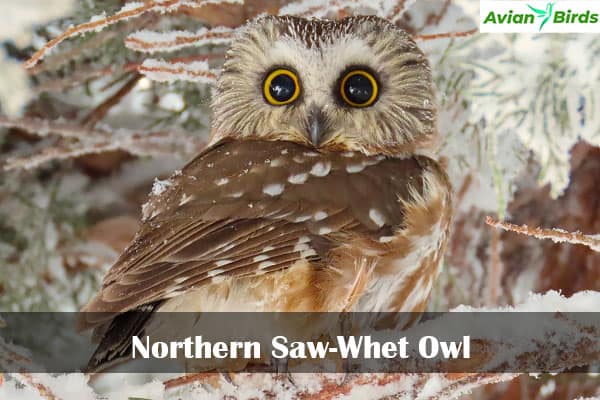
- Scientific name: Aegolius acadicus
- Life span: 7 to 17 years
- Size: 17 to 22 centimeters (6.7 to 8.7 inches)
- Weight: 54 to 151 grams (1.9 to 5.3 ounces)
- Wingspan: 42 to 56.3 centimeters (16.5 to 22.2 inches)
- Conservation Status: Least Concern
The Northern Saw-whet Owl is a small owl species that can be found in Colorado, making it one of Colorado’s owl species. Despite its small size, this owl is known for its unique nesting habits and distinctive calls.
When it comes to nesting, the Northern Saw-whet Owl prefers to make its home in tree cavities or abandoned woodpecker nests. They also have a preference for coniferous forests, where they blend in seamlessly with their surroundings. These owl species have a remarkable ability to camouflage themselves, making them difficult to spot during the day.
The Northern Saw-whet Owl is known for its distinctive “toot” or “hooting” calls during breeding season. It is quite an adorable sound and can often be heard throughout the night in their preferred habitats.
Despite their small size, Northern Saw-whet Owls are formidable hunters. They primarily feed on small mammals such as mice and voles, capturing their prey with precision and agility. These small owl species are often active during the twilight hours, hunting under the cover of darkness.
The Northern Saw-whet Owl in Colorado
In Colorado, the Northern Saw-whet Owl can be found in various regions, including the montane and subalpine forests. During the breeding season, these owls establish territories and can be heard calling to attract mates. Their presence in the Colorado wilderness adds to the rich diversity of owl species in the state.
| Characteristics | Description |
|---|---|
| Size | Approximately 7-8 inches in length |
| Appearance | Brown plumage with white spots; rounded head with bright yellow eyes; hooked beak |
| Habitat | Coniferous forests, montane and subalpine forests |
| Diet | Small mammals, primarily mice and voles |
| Unique Trait | Distinctive “toot” or “hooting” calls during breeding season |
The Northern Saw-whet Owl is a fascinating member of Colorado’s owl species. Its small size, unique nesting habits, and distinctive calls make it a special owl to encounter in the wild.
8. Burrowing Owl

- Scientific name: Athene cunicularia
- Life span: 6-8 years
- Size: 8-11 inches (20-28 centimeters)
- Weight: 5.3-8.5 ounces (150-240 grams)
- Wingspan: 20-24 inches (51-61 centimeters)
The Burrowing Owl is a fascinating owl species found in Colorado. These owls are known for their unique nesting behavior, as they prefer to make their homes in underground burrows. They are specifically adapted to living in open, arid environments such as plains, deserts, and grasslands.
Burrowing owl populations have faced significant threats in recent years, primarily due to habitat loss caused by urbanization and changes in land use. Human activities such as agriculture and development have destroyed burrowing owl habitat.
Despite being small in size, Burrowing Owls are highly skilled hunters. They feed primarily on small mammals, insects, and other small birds. Their hunting technique involves perching on low branches, fence posts, or even on the ground near their burrows, scanning the area for potential prey.
Burrowing owls in Colorado have distinctive appearances that set them apart from other owl species. They have long legs and short tails, along with a speckled brown and white plumage that provides excellent camouflage against their natural environment.
One interesting behavior of Burrowing Owls is their ability to mimic rattlesnake sounds by rapidly shaking their feathers or clapping their beaks. This behavior serves as a defensive mechanism, deterring potential predators from approaching their nests.
Conservation efforts are being made to protect the Burrowing Owl population in Colorado. Measures such as preserving and restoring their natural habitat, implementing land management practices that support their burrowing needs, and raising awareness among local communities are crucial for their survival.
| Characteristics | Description |
|---|---|
| Size | Approximately 8 to 11 inches tall |
| Wingspan | Around 20 inches |
| Habitat | Open plains, grasslands, deserts |
| Diet | Small mammals, insects, small birds, including those studied by the Colorado Avian Research and Rehabilitation Institute |
| Nesting | Underground burrows |
| Threats | Habitat loss, urbanization, land use changes |
9. Flammulated Owl in Colorado
The Flammulated Owl is a small owl species that can be found in Colorado. With its distinct brown and white plumage, this owl is easily recognizable in its natural habitat. Despite its small size, the Flammulated Owl captures our fascination with its charming appearance and intriguing behavior.

These owls prefer to nest in coniferous forests, particularly in areas with dense tree cover. They are more active during the night, using their excellent hearing to locate prey such as insects and small rodents. The Flammulated Owl’s diet consists mainly of moths, beetles, and mice.
During the breeding season, the male Flammulated Owl serenades its potential mate with a unique hooting call that carries through the forest. Their nest sites are typically holes in tree trunks or snags, providing a secure and hidden location for their offspring. Protected by the dense forest canopy, these owls ensure the safety and success of their brood.
As one of Colorado’s owl species, the Flammulated Owl is an important part of the state’s wildlife diversity. Its presence in the forests of Colorado adds to the natural beauty and ecological balance of the region. By understanding more about this small owl species and its habitat preferences, we can continue to appreciate and protect Colorado’s diverse owl populations.
10. Northern Pygmy Owl
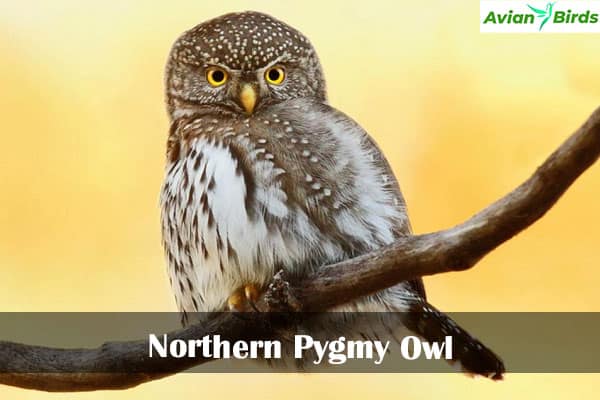
The Northern Pygmy Owl, a small but captivating bird, is widespread throughout North America, from Alaska to Mexico. It stands out with its round head, striking yellow eyes, and dark bill that contrasts sharply.
Besides this, the color of the Northern Pygmy Owl’s feathers varies depending on where it lives, showing shades from grey to brown with touches of white. Known for its skillful hunting, it has been seen catching birds much larger than itself, like quails and jays.
Additionally, these owls typically make their homes in natural tree hollows or abandoned woodpecker nests, sometimes using man-made nest boxes. They usually lay between 3 and 7 eggs, carefully keeping them warm for about a month. Once born, the baby owls spend about four weeks in the nest before they’re ready to fly.
Plus, in Colorado, the Northern Pygmy Owl feeds on a variety of prey, including small birds, mammals, and insects. Like the Short-Eared Owl, it hunts both day and night, giving it an edge in catching its food.
Furthermore, the Northern Pygmy Owl is threatened in Colorado because of habitat loss and fragmentation caused by humans and climate change. Despite efforts to protect them, their numbers in Colorado remain low, highlighting the ongoing need for conservation. However, on a global scale, the species is considered of “Least Concern” by the IUCN.
11. Western Screech Owl
The Western Screech Owl, a stout little bird, inhabits the western areas of North America, from Mexico up to Canada. With their notable ear tufts, piercing yellow eyes, and a mix of brown and grey feathers, these owls are quite a sight to see.
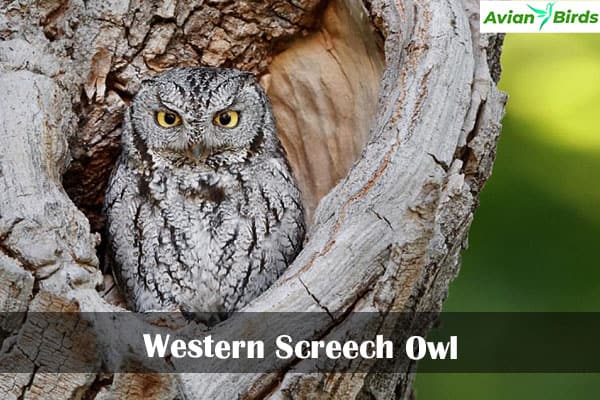
Despite being the tiniest owl in North America, their call is surprisingly powerful and can be heard from afar! Interestingly, Western Screech Owls produce a distinct call resembling a bouncing ball or a softly whistling sound.
These owls prefer nesting in tree hollows or abandoned woodpecker nests, and they’re also known to utilize human-made nest boxes, which are often set up by organizations like the Colorado Avian Research and Rehabilitation Institute to support their populations. Breeding typically begins in late winter or early spring, with the female laying 2-4 eggs. Both parents share the task of keeping the eggs warm, which hatch after about a month. The fledglings leave the nest after approximately 30-35 days.
In Colorado, Western Screech Owls dine on a variety of prey, including insects, small mammals, birds, and reptiles, along with spiders and scorpions. They’re adaptable hunters, making the most of whatever food is available in their surroundings.
Unfortunately, Western Screech Owls in Colorado have faced a decline in population due to habitat loss and pesticide use. Conservation efforts involve safeguarding and restoring their habitats, as well as setting up nest boxes. Thankfully, on a global scale, they’re not in immediate danger, as they’re classified as “Least Concern” on the IUCN Red List.
12. Snowy Owl
The Snowy Owl, an impressive and symbolic bird of the Arctic tundra, commands attention with its dazzling white plumage and sharp yellow eyes. These magnificent creatures inhabit the northern reaches of North America, Europe, and Asia.
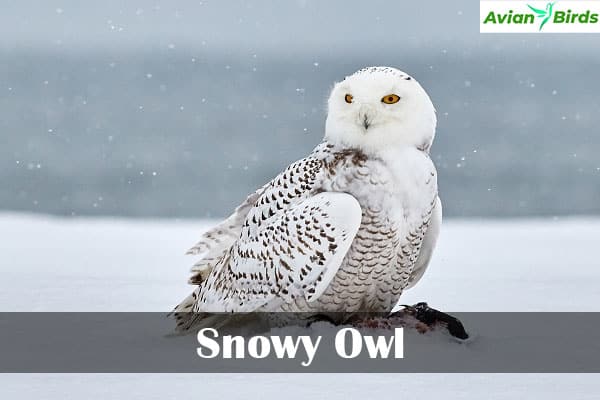
Setting them apart from most other owls, Snowy Owls sport feathers on their legs and feet, a feature that aids in regulating body temperature and shielding against the cold. Their remarkable hearing is another notable trait, enabling them to detect prey even beneath thick layers of snow.
Nesting on the ground, often on small mounds within the tundra landscape, Snowy Owls in Colorado occasionally repurpose natural ground indentations or abandoned nests from birds like Arctic Terns. These owls exhibit monogamous behavior and frequently revisit familiar nesting sites.
Feeding primarily on lemmings, Snowy Owls occasionally diversify their diet with rodents, birds, and fish. Their adaptability as opportunistic hunters allows them to capitalize on various food sources available in their surroundings.
Regrettably, Snowy Owls face a “Vulnerable” status according to the IUCN, attributable to declining populations in specific regions. Habitat loss and climate change stand as prominent factors contributing to significant disruptions in their natural habitats. Additionally, historical hunting for their prized feathers exacerbated their plight in the past.
Check Our Previous Articles:
Frequently Asked Questions About Owls in Colorado
Q1. Are owls common in Colorado?
Yes, owls are fairly common in Colorado.
Q2. Where can I see owls in Colorado?
You can see owls in various habitats across Colorado, including forests, open fields, and even suburban areas.
Q3. What is the most common owl in Colorado Springs?
The most common owl in Colorado Springs is the great horned owl.
Q4. What is the smallest owl in Colorado?
The smallest owl in Colorado is the northern pygmy owl.


